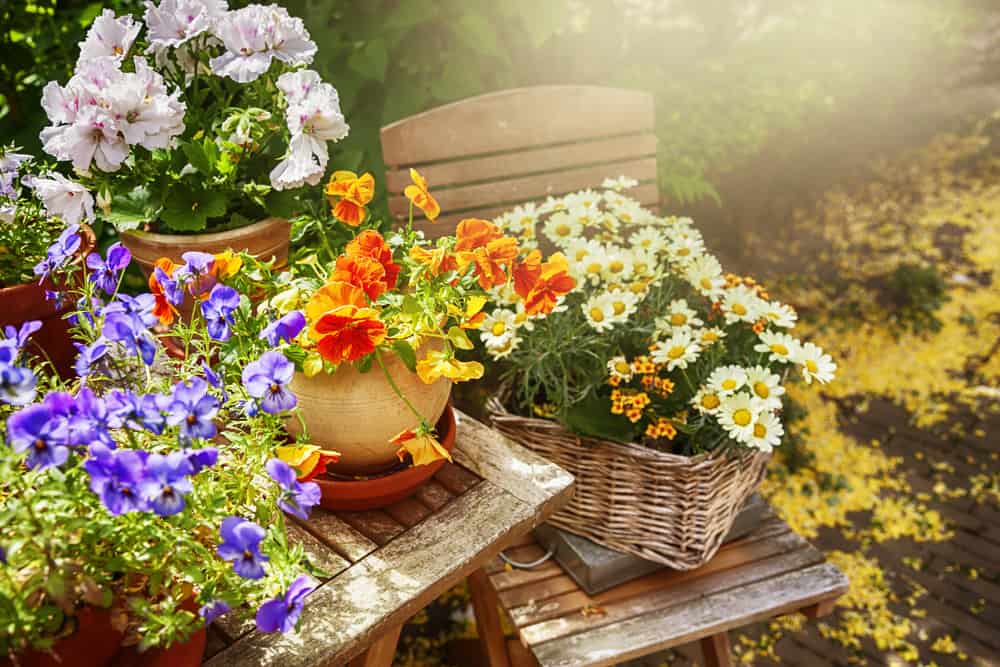Moving into a senior living community doesn’t have to mean hanging up your gardening gloves. In fact, many independent living apartments feature patios or balconies where you can grow a lush garden that makes your living space more personal and inviting.
Keep reading to learn how to maintain a patio garden like a pro with these container gardening tips, and explore which native plants you can expect to flourish into a blossoming garden under your care.
Growing a Blossoming Garden on Your Senior Apartment Patio
Window shop before buying. When you visit a nursery filled with beautiful garden plants and flowers, it’s easy to let your enthusiasm take over. Before you go wild buying, take time to do some research. Plant tags will provide essential information to help you plan your patio garden for better results. On your first trip, make notes about the plants that catch your eye, including details such as how big they’ll grow and their requirements for sunlight.
Be mindful of your lighting. Back at your apartment, observe how the sun hits the space you plan to use for your patio garden during different times of the day. Compare what you find to your notes from the plant tags. Adjust your choices accordingly, and if necessary, go back to the nursery and look for more plants that fit with your lighting.
Choose containers carefully. Two important factors will influence the containers you use for your patio garden: the space you have available and the room your plant’s roots will need to grow into maturity. Another potential variable is your own needs; if bending over pots will strain your back or knees, choose a raised bed or window boxes that will make it easier to reach and care for your garden. Larger containers are usually easier to grow in than smaller ones, but you’ll need to avoid overfilling them so plants have room to grow and roots don’t tangle.
Pay attention to drainage. If your containers don’t have enough holes of an adequate size to release excess water, your soil will stay too wet and your roots will suffer. For smaller to mid-size pots, drain holes should be at least 1/2 inch wide; larger pots require an inch or more. If you’re worried soil will spill out of the holes, use a stone or bit of gravel to obstruct the hole while still leaving plenty of room for water to escape.
Make native plants your priority. Native plants and flowers tend to be hardiest for your climate, and because they’re well-suited for the environment, they’ll require less care and maintenance. Remember that with proper care, perennials will return year after year, so you can plant once, then look forward to those first hints of fresh growth each spring.
New Jersey native plants
If you’re a long-time New Jersey resident, you may already be familiar with some of the native vegetation that thrives in this New England climate. If you’re new to the area, or new to gardening, there are numerous resources for identifying native plants, including this list of perennials that includes the latin name, common name, colors, and traditional blooming season for each from the Lady Bird Johnson Wildflower Center:
- Achillea millefolium (common yarrow) – white or pink, mid-July to September
- Aquilegia canadensis (red columbine) – red and yellow, April to July
- Asclepias tuberosa (butterfly milkweed) – orange, May to September
- Campanula rotundifolia (bluebell bellflower) – blue or purple, June to September
- Coreopsis lanceolata (lanceleaf tickseed) – yellow, April to June
- Lobelia cardinalis (cardinal flower) – red, July to October
- Lobelia siphilitica (great blue lobelia) – blue, July to August
- Monarda didyma (scarlet beebalm) – red, July and August
- Phlox subulata (moss phlox) – blue, March to June
- Rudbeckia laciniata (cutleaf coneflower) – yellow, July to October
- Symphyotrichum novi-belgii (New York aster) – pink or purple, August to October
Other ways to garden
Craving more ways to use your green thumb? Look into gardening clubs, special programs, and offerings within your community. For example, residents of Stonebridge at Montgomery put their gardening skills to use in a large resident-run greenhouse and outdoor garden plot. Residents plant a stunning selection of flowers, design dazzling arrangements to brighten up their senior apartments, and grow their own spices and produce to enhance their home-cooked meals.
In addition, Executive Chef Paul Robinson borrows inspiration from residents’ bountiful crops by using ingredients picked straight from the garden to create the unique and nutritious meals served in the dining room.
Plan a visit to Stonebridge at Montgomery, where you can tour senior apartments with patios and balconies prime for a patio garden, as well as visiting the greenhouse, garden, and other amenities that make living in this Life Plan Community so rewarding.



